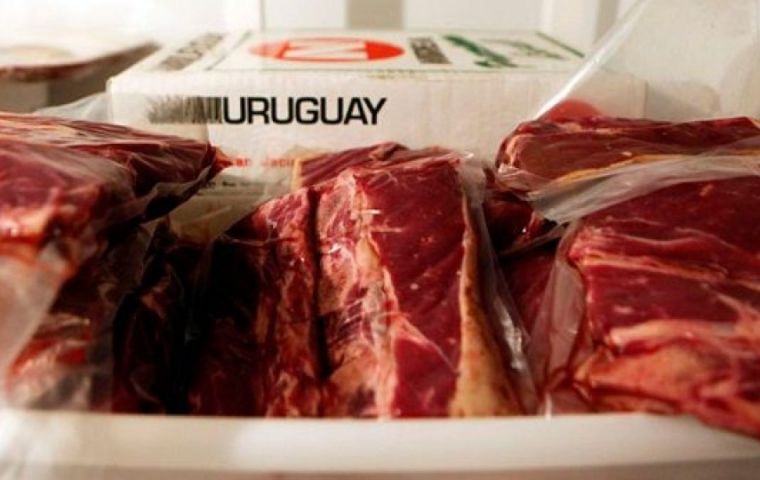MercoPress. South Atlantic News Agency
Hong Kong emerges as destination of meat exports from Paraguay, Uruguay
 Hong Kong seems to be the answer for meat sales
Hong Kong seems to be the answer for meat sales While Uruguay's National Meat Institute (INAC) eyes China, Saudi Arabia and Hong Kong as the clients to target, the latter has already recorded an increase of 13% in both volume and revenues in purchases from Paraguay, according to a Central Bank (BCP) report released this week.
An INAC report showed Uruguay was a marginal supplier of beef and poultry meat to the world and recommended sales be aimed at those three potential buyers to increase performances.
According to data from July this year, Hong Kong has become the seventh largest destination for Paraguayan meat.
The INAC document also calls for improvements in the access to international markets to bolster the development of the domestic poultry meat chain.
Poultry is the meat most consumed in the world. In 2020 the international poultry meat market reached US $ 22,500 million and 14 million tons traded, representing 22% of the international trade in animal protein in value and 39% in volume. According to the United States Department of Agriculture (USDA), the average per capita consumption of poultry meat worldwide in 2020 was approximately 13 kilos and that is 3% higher than pork and 68% higher than beef.
The high level of demand for poultry meat worldwide is explained, in part, by its lower relative price compared to the rest of animal proteins. The commercialized volume of poultry meat worldwide has grown at an average rate of 2% per year in the last decade and the growth rate of the consumption of poultry meat is higher than the rest of animal proteins.
The international poultry meat market is more concentrated in supply than in demand. There are four exporters that supplied 75% of the world market in value in 2020: Brazil, the United States, the European Union and Thailand.
On the demand side, 19 importers accounted for this proportion. As a reference, to reach similar figures in the 75% of the beef market it is necessary to consider seven exporters and 10 importers.
Regarding the commercialized products, 80% of world trade is explained by the cut chicken trade, and only 20% by whole chicken. In addition, the sliced chicken segment has grown by 40% in value between 2010 and 2019, while the whole segment reduced its marketed value by 10%. Poultry chopping allows countries to optimize their supply and consumption in terms of specific cuts.
The exports of Uruguayan poultry in the last decade are marked by a drastic process of entry and withdrawal from the Venezuelan market, the INAC research explained. Between 2010 and 2014, 69% of the export of Uruguay's poultry meat in value was shipped to Venezuela, worth around US $ 24 million. Commercial problems led to the discontinuation of exports to that market. The annual average of exports between 2015 and 2019 fell to US $ 4 million, a level lower than the previous five-year period, even excluding what was sold to Venezuela. Since then, the Middle East has been the main destination for exported Uruguayan poultry meat.
The basket of products exported by Uruguay is concentrated in whole chickens, which implies a mismatch of the Uruguayan supply with respect to international demand.
INAC has developed a Market Access Index (IAM), which gives scores to exporting countries between 0 and 100. Uruguay has access to 4% of the international poultry meat market. This is a low level of access both in comparison with the countries of the region and with the other meat products that Uruguay exports. Brazil, Chile, Argentina and Paraguay access 84%, 46%, 37% and 15% of the market, respectively.
This situation is the result of a deterioration process. In 2010, Uruguay exported to about a third of the import market. Between 2010 and 2020, relevant sanitary authorizations were lost (Hong Kong and Saudi Arabia) and trade with markets that remain open (Russia, Venezuela, Vietnam, Ghana, etc.) was discontinued.
In this scenario, INAC has recommended prioritizing potential customers as per their cost/benefit indexes, for which the following questions needed answers: Has Uruguay already been authorized to export poultry meat to the target market? Does Uruguay have other meat products allowed into the target market? Is the target market supplied by several exporters with heterogeneous market access levels or only by those with the best scores?
The answer to those questions yielded the following response: China, Saudi Arabia and Hong Kong need to become a priority. If things go according to INAC's plan, Uruguay would increase its performance from 4% to 36%, the same level of access of relevant exporters such as Argentina and Thailand.
Hong Kong is already highly interested in purchasing meat from this region. Between January and July 2021, 6.2 thousand tons of Paraguayan beef were exported, against 5.5 thousand tons in the same period of 2020.
Paraguayan sources also showed a 0.2% increase in the price of meat compared to the same period in 2020, which needs to be calculated when measuring volumes and revenues.




Top Comments
Disclaimer & comment rulesCommenting for this story is now closed.
If you have a Facebook account, become a fan and comment on our Facebook Page!